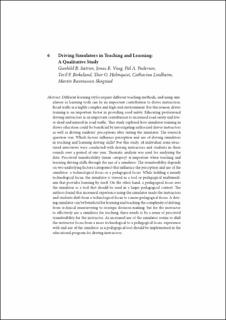| dc.contributor.author | Sætren, Gunhild Birgitte | |
| dc.contributor.author | Vaag, Jonas Rennemo | |
| dc.contributor.author | Pedersen, Pål Andreas | |
| dc.contributor.author | Birkeland, Toril Fagerli | |
| dc.contributor.author | Holmquist, Thor Owe | |
| dc.contributor.author | Lindheim, Catharina | |
| dc.contributor.author | Skogstad, Martin Rasmussen | |
| dc.date.accessioned | 2021-06-17T08:09:46Z | |
| dc.date.available | 2021-06-17T08:09:46Z | |
| dc.date.created | 2021-03-16T06:39:12Z | |
| dc.date.issued | 2021 | |
| dc.identifier.citation | Sætren, G. B., Vaag, J. R., Pedersen, P. A., Birkeland, T. F., Holmquist, T. O., Lindheim, C. & Skogstad, M. R. (2021). Driving simulators in teaching and learning: A qualitative study. In A. Strømmen-Bakhtiar, R. Helde & E. Suzen, (Eds.), Supplemental Instruction. Volume 1: Digital Technologies (p. 67-86). Waxmann Verlag. doi: | en_US |
| dc.identifier.isbn | 978-3-8309-4324-2 | |
| dc.identifier.uri | https://hdl.handle.net/11250/2759889 | |
| dc.description.abstract | Background: Different learning styles require different teaching methods, and the use of simulator as a learning tool can thus be an important contribution to driver instruction. Road traffic is a highly complex and high-risk environment. For this reason, driver training is an important factor of providing road safety. Educating professional driving instructors is an important contribution to increased road safety, and fewer dead and injured in road traffic. This study explored how simulator training in driver education could be beneficial by investigating authorized driver instructors as well as driving instructor students’ perceptions after testing the simulator. Our research question was: Which factors influence perception and use of driving simulators in teaching and learning driving skills? For this study, 28 individual semi-structured interviews were conducted of driving instructors and students of driving instructors in three rounds over a period of one year. Thematic analysis was used for analysing the data. Results: We found that perceived transferability (main category) is of importance when teaching and learning driving skills through the use of a simulator. The transferability is dependent upon two underlying factors (categories), that seems to influence the perception and use of the simulator: 1) a technological focus or 2) a pedagogical focus. While holding a mainly technological focus, the simulator is viewed as a tool or pedagogical multimedium that provide learning by itself. On the other hand, a pedagogical focus sees the simulator as a tool that should be used in a larger pedagogical context. We found that increased experience of using the simulator technology seemed to influence the instructors and instructor students to shift from a technological focus, to a more pedagogical focus. Conclusion: A driving simulator has the possibility to be beneficial for learning and teaching the complexity of driving, from technical manoeuvring to strategic decision making, but for the instructor to effectively use a simulator for teaching, there need to exist a sense of perceived transferability for the instructor. As increased use of the simulator seems to shift the instructor focus from a more technological to a pedagogical focus – experience with and use of the simulator as a pedagogical tool should be implemented in the educational program for driving instructors. Keywords: learning, simulator, driver training, driver instructor education, higher education, simulation-based teaching, experiential learning, technology acceptance | en_US |
| dc.language.iso | eng | en_US |
| dc.publisher | Waxmann Verlag | en_US |
| dc.relation.ispartof | Supplemental Instruction Volume 1: Digital Technologies | |
| dc.rights | Attribution-NonCommercial-NoDerivatives 4.0 Internasjonal | * |
| dc.rights.uri | http://creativecommons.org/licenses/by-nc-nd/4.0/deed.no | * |
| dc.subject | Sikkerhetspsykologi | en_US |
| dc.subject | Safety psychology | en_US |
| dc.subject | Læringspsykologi | en_US |
| dc.subject | Læringspsykologi | en_US |
| dc.title | Driving simulators in teaching and learning : A qualitative study | en_US |
| dc.type | Chapter | en_US |
| dc.type | Peer reviewed | en_US |
| dc.description.version | publishedVersion | en_US |
| dc.subject.nsi | VDP::Andre psykologiske fag: 279 | en_US |
| dc.subject.nsi | VDP::Other subjects within psychology: 279 | en_US |
| dc.subject.nsi | VDP::Samfunnsvitenskap: 200::Pedagogiske fag: 280 | en_US |
| dc.source.pagenumber | 67-86 | en_US |
| dc.identifier.doi | 10.31244/9783830993247 | |
| dc.identifier.cristin | 1898219 | |
| dc.relation.project | The Norwegian Research Council: 260524 | en_US |

